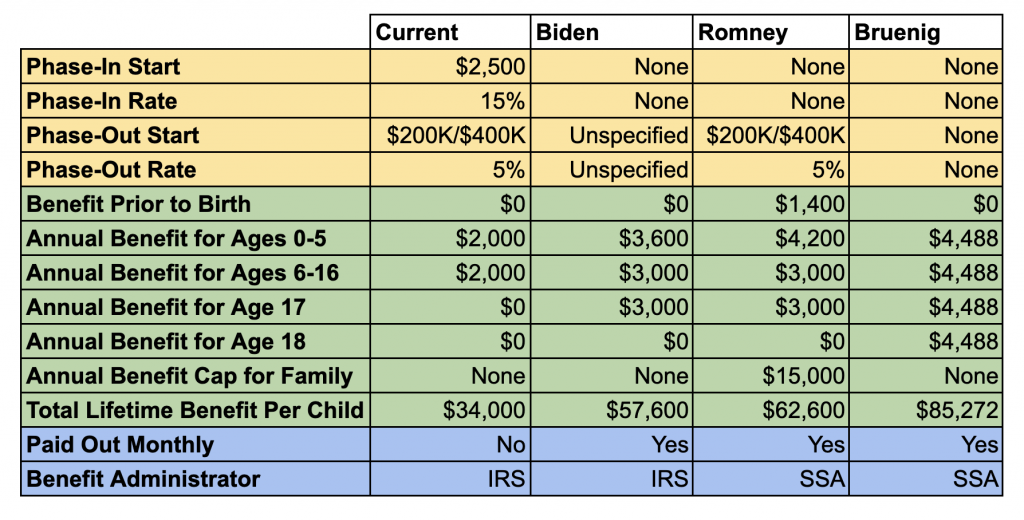Mitt Romney released a proposal today to replace the Child Tax Credit (CTC) with a new child allowance program administered by the Social Security Administration (SSA). Under the Romney Plan, children would receive $1,400 just prior to birth, $4,200 per year for ages 0 to 5, and $3,000 per year for ages 6 through 17.
The maximum benefit for any given family would be $15,000 per year, which effectively means that benefits are capped at 3.5 to 5 children depending on their ages. The benefit would also be paid out monthly.
To get a sense of how the Romney proposal stacks up to the Biden proposal and to my own proposal, I have condensed most of the plan details into the following table.

All three plans get rid of the benefit phase-in contained in our current system, meaning that the poor would no longer be excluded, by rule, from child benefits. The Romney plan maintains the current phase-out thresholds. The Biden plan has not committed to a specific phase-out threshold but it seems likely that they will reduce those thresholds so that the benefit phases out more quickly than in the status quo. My plan has no phase-out.
The Biden plan provides lifetime benefits of $57,600 per child. The Romney plan provides $5,000 more than that for a total of $62,600. My own plan clocks in at $85,272. The Romney plan is the only one that provides some benefits just prior to birth while my plan is the only one that covers 18-year-olds.
As far as administration goes, all three plans would use monthly payments. Biden’s proposal continues to use the Internal Revenue Service (IRS) to pay out the benefits while the Romney proposal and my proposal switch to the Social Security Administration (SSA).
Better Than Biden, Worse Than Me
The Romney plan is an improvement over the Biden plan in three ways. First, it provides more benefits. Second, it uses the Social Security Administration, which should increase participation, among other things. Third, it likely phases out at a higher income level than Biden’s plan does, which will make the program easier to administer and more universal in its coverage.
There are of course still significant downsides to the Romney plan relative to my own. The Romney plan has a benefit cap, which means that some large families will not receive their fair share. It also uses a phase-out, which will create administrative hassles that reduce participation among populations that we should be trying to reach. The benefit cap and phase-out are especially weird because each of them are set so high that they are not going to reduce spending by any meaningful amount. So they are creating administrative headaches for no real purpose.
Controversial Payfors
Unlike the other proposals currently floating around in the discourse, Romney lays out a specific set of payfors that also rationalize the child benefit system to some degree. It is these proposals, which are presented separately from the benefit, that are likely to draw the ire of organizations like Center on Budget and Policy Priorities and the Democratic politicians that they influence.
The controversial payfors are:
- Eliminate the State and Local Tax Deduction (SALT).
- Eliminate the Child and Dependent Care Tax Credit (CDCTC).
- Eliminate the Head of Household (HoH) filing status.
- Convert the Earned Income Tax Credit (EITC) into a child-agnostic benefit that has a maximum benefit of $1,000 for single filers and $2,000 for married filers.
- Eliminate the federal block grant for Temporary Assistance for Needy Families (TANF).
The first item, eliminating the SALT deduction, would raise taxes on rich people, which is actually good. But Democrats like the SALT deduction because it disproportionately directs money to their districts and states, which makes it controversial.
Items (2) and (3) are reasonable ways to rationalize the current system as part of implementing a child allowance program. Indeed, I advocated for both of them in my Family Fun Pack paper released in 2019. The CDCTC is a mess of a trapezoid program that excludes the poor. The HoH filing status also excludes the poor and provides tax relief that is directly proportional to how much income someone has, meaning that it provides more to high-earners than middle-earners. Cutting these policies and moving their savings into the child allowance pot makes good sense, distributively speaking.
Item (4) is where things start to get a little tricky. Under the Romney proposal, a single mother with one child at the peak of the EITC plateau would receive $1,000 from the EITC and $4,200 (if their child is under 6) or $3,000 (if their child is over 5) from the child allowance. Under our current system, that same parent would be eligible for a combined $5,420 (in 2021) from the EITC and the CTC. This is $220 more than in the younger-child scenario and $1,420 more than in the older-child scenario.
For the younger-child scenario, the fact that the current tax credits only have 78 percent participation, do not pay out monthly, and only arrive at the beginning of the subsequent year means that the Romney proposal is still better on average, even at this sweet spot in the tax credit distribution.
For the older-child scenario, it gets dicier. Technically, if you account for the 78 percent participation rate in tax credit programs, the average gap between the current system and the Romney proposal for the older-child scenario is $448, not $1,420. Is getting paid monthly and not having to wait until the end of the year worth $448? That’s tough to say. But even if you think it is not, whatever dollar gap that remains for this particular family is overwhelmed by the fact that in the Romney scheme the poorest of the poor get the full child allowance while in our current system they get nothing.
In general, I think Romney would be wise to either up the EITC amount for single filers (in the Family Fun Pack paper, it is set at $2,000) or make it so that the younger-child benefit is extended to all children (as in my more recent child benefit paper).
Item (5) is the one that will generate the most ire though that ire is likely to be the most overblown. TANF is the program that replaced Aid to Families with Dependent Children (AFDC) after the 1996 welfare reform. In 1997, the federal government allocated $16.5 billion to this block grant program. In 2019, it allocated the exact same amount of money, which was worth 40 percent less than in 1997 in inflation-adjusted terms. Over that same period, the share of TANF block grants that went out as cash assistance to poor families with children declined from 71 percent to 21 percent. Taken together, this means that federal spending on TANF cash assistance has fallen by 82 percent since 1997. In 2019, it was only $3.5 billion. For comparison, food stamp benefits in 2019 totaled $55 billion.
Put simply, TANF is a completely hollowed-out program that has been on a decades long death march that nobody has had any success reversing. States loot the ever-shrinking pot of money for other uses rather than pay it out to families and almost nobody who is theoretically eligible for TANF based on their income actually gets it.
Given all of this, it remains true that the Romney plan would be better for poverty even if you also eliminated the federal support for TANF (in the plan, state support, which is where the majority of TANF funding comes from, remains). But it is precisely because TANF is in a death spiral that it seems weird to target it in this way. You don’t need to kill TANF. It is killing itself.
Conclusion
Based on the benefit design alone, it’s clear that Romney’s proposal, due to its generosity and administrative simplicity, is an improvement on the Biden proposal. Bringing in these payfors makes it closer, but the Romney proposal still edges the Biden proposal out. Democrats should of course be supporting a universal child benefit proposal like the one I have outlined. But short of that, they would be wise to use the Romney proposal as a starting point and then build from there. It provides a much more solid foundation than the American Family Act that Democrats have been using and any unsavory payfors are easily swapped out as the benefit is actually not very expensive.

